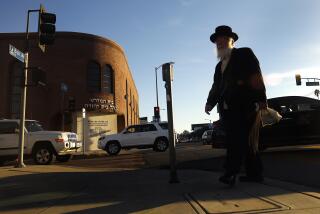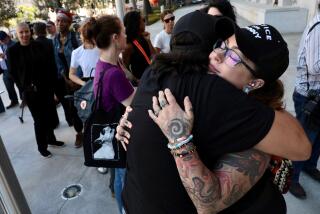Ratcheting Up Raids, LAPD Sends a Message
It was 7:15 in the evening, and across South Los Angeles, several hundred police officers were trying to be very, very quiet.
They were about to burst into action all at once -- 37 separate police units in 37 different places, spread out within a few square miles east of the Harbor Freeway.
The Oct. 23 raids -- involving searches and arrests -- were designed to fetter the activities of two local street gangs.
Such operations are being emphasized more in the Los Angeles Police Department. As part of a new strategy pushed by Chief William J. Bratton, police say they are trying to serve more search warrants and are conducting larger raids, such as those last week. Twenty-eight people were eventually arrested, most on suspicion of drug-related or weapons-related crimes. Police said 19 were charged or otherwise remain in custody.
“It’s not efficient and not good policing to just respond to calls,” said Cmdr. Jim Tatreau of the department’s 77th Street Division, where most of last week’s warrants were served. Search warrants, he said, “put you into people’s homes, cars and hangouts. Nothing is sacred.”
His division has been a focus of such efforts. It straddles the Harbor Freeway south of Vernon Avenue and has the highest number of violent crimes of any LAPD division. The number of search warrants served there has ballooned from 46 during all of last year to 84 in the first 10 months of 2003.
“In my view, bigger is better. It lets people know we are doing our part to combat narcotics and gangs,” said Officer Mike Fletcher, one of the narcotics investigators who took part in the operation.
Besides catching wrongdoers, LAPD officials say, the search warrant operations are meant to prevent crime. They argue that the raids warn associates of those arrested -- gang members -- that the police are poised to take action. Police also say such efforts yield clues to other crimes -- a gun confiscated here, a tip offered by a suspect there.
In addition, the large operations are meant to improve community relations, Tatreau said.
Two teenagers, Quinesha Dunford, 15, and Demario Moore, 13, were killed Sept. 10 in the same neighborhood where the warrants were served. Three people have been arrested and charged in the case -- 18-year-old Marcel Harling and two others, whose names were not released because they are juveniles.
Although the suspects in the case were caught, the double homicide “just cries out that it deserves ... something special,” Tatreau said. “People ... don’t just want us to cover the bodies and pick up the pieces. They want to know ... that we will be back tomorrow.”
Officers in the Oct. 23 operation were directed to strike at the same instant. About 7:20 p.m., the orders began going out -- “all narcotics squads, go, go, go,” followed by calls to other squads. Officers then rushed front doors.
At 52nd and Hoover streets, for example, three police cars pulled up to the curb in front of a small Craftsman-style house under a large shade tree. Officers poured out, shouting at a man who happened to be walking out of the house next door at the same moment. He dropped his cigarette and tentatively placed his hands on his head.
At the door of the Craftsman house, there was the sound of a small child screaming. Then the officers walked a man wearing pajama pants out of the house in handcuffs. A few neighbors watched. A couple with a stroller glanced at the scene, then crossed to the other side of the street.
The man was released: He was the suspect’s father, police said later.
One neighbor, 39, who identified herself only as Martha, said she was pleased. The corner near the house “is very suspicious. You see a lot of people just visiting,” she said. “I’m glad [the police] are here. That way it can be cleaned up a little.”
Not all shared this view, though. At 50th Street and Normandie Avenue, Ronald Swan, a 56-year-old blind veteran of the Vietnam War, listened with employees at a restaurant to another raid unfolding next door.
The police “come out making a big scene, but they don’t give the youngsters here a job,” he said. “Why not bust the people who are bringing the drugs in, instead of these young kids? There are drugs in white areas too, you know.”
Next door, police were uncovering what they said were clear signs of narcotics sales, though no suspects. Detectives found apartments in the building equipped with video surveillance systems rigged to cameras mounted on the roof. They found rock cocaine inside an apartment with a custom metal door, and two guns between mattresses on a bed.
At other locations, officers said, they did find people named in the warrants.
One person who was detained then released, however, was Gregory Johnson, 18, who said he was mistakenly accused of leaving a drug location. Police handcuffed him then let him go.
Johnson said he felt that several officers treated him with disrespect.
“Yes, that’s what the police should be doing,” Johnson said of the raids. “But they need to be extra cautious.... Just locking everyone up when something happens doesn’t get you to the core issue.”
Detectives respond that limits on the use of wiretapping and a lack of resources prevent them from targeting bigger fish -- that is, higher-level gang operatives most responsible for ordering street violence. But they also say they are careful to target suspects involved in serious crime.
Det. Mike Steward said he spent two months preparing his application for a warrant. Judicial officers approved it in about an hour, he said.
Fletcher, the narcotics investigator, said: “We are trying to identify people involved in these crimes, do work-ups on them and surveillance on them. A lot of work went into this. A lot of blood and sweat.”
Among those nabbed were two juveniles and one adult suspected of assault with a deadly weapon. The adult suspect was later released, Steward said. Prosecutors were still weighing charges against the juveniles earlier this week.
More to Read
Sign up for Essential California
The most important California stories and recommendations in your inbox every morning.
You may occasionally receive promotional content from the Los Angeles Times.









